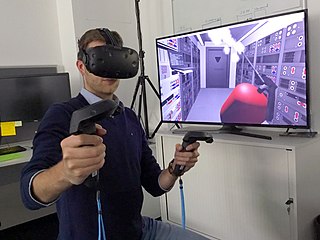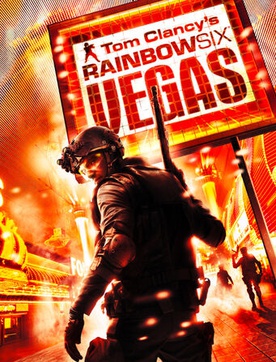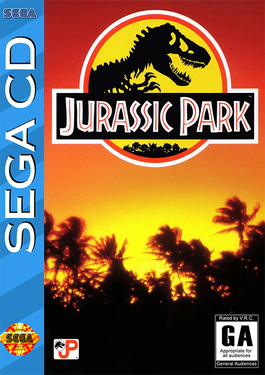
The Jaguar is a home video game console developed by Atari Corporation and released in North America in November 1993. It is in the fifth generation of video game consoles, and it competed with fourth generation consoles released the same year, including the 16-bit Genesis, the 16-bit Super NES, and the 32-bit 3DO Interactive Multiplayer. Jaguar has a Motorola 68000 CPU and two custom 32-bit coprocessors named Tom and Jerry. Atari marketed it as the world's first 64-bit game system, emphasizing its blitter's 64-bit bus; however, none of its three processors have a 64-bit instruction set, as do later 64-bit consoles such as PlayStation 2 or Nintendo 64. The Jaguar launched with Cybermorph as the pack-in game, which received mixed reviews. The system's library ultimately comprises only 50 licensed games.

System Shock is a 1994 first-person action-adventure video game developed by LookingGlass Technologies and published by Origin Systems. It was directed by Doug Church with Warren Spector serving as producer. The game is set aboard a space station in a cyberpunk vision of the year 2072. Assuming the role of a nameless security hacker, the player attempts to hinder the plans of a malevolent artificial intelligence called SHODAN.

Virtual reality (VR) is a simulated experience that employs 3D near-eye displays and pose tracking to give the user an immersive feel of a virtual world. Applications of virtual reality include entertainment, education and business. VR is one of the key technologies in the reality-virtuality continuum. As such, it is different from other digital visualization solutions, such as augmented virtuality and augmented reality.

Roberta Lynn Williams is an American video game designer and writer, who co-founded Sierra On-Line with her husband, game developer Ken Williams. In 1980, her first game, Mystery House, became a modest commercial success; it is credited as the first graphic adventure game. She is also known for creating and maintaining the King's Quest series, as well as designing the full motion video game Phantasmagoria in 1995.
Legend Entertainment Company was an American developer and publisher of computer games, best known for creating adventure titles throughout the 1990s. The company was founded by Bob Bates and Mike Verdu, both veterans of the interactive fiction studio Infocom that shut down in 1989. Legend's first two games, Spellcasting 101: Sorcerers Get All the Girls and Timequest, had strong sales that sustained the company. Legend also profited from negotiating licenses to popular book series, allowing them to create notable game adaptations such as Companions of Xanth and Gateway. Legend also earned a reputation for comedic adventures, with numerous awards for Eric the Unready in 1993. As the technology of the game industry changed, Legend continued to expand its game engine to take advantage of higher graphical fidelity, mouse support, and the increased media storage of the compact disc.

The 7th Guest is an interactive movie puzzle adventure game, produced by Trilobyte and originally released by Virgin Interactive Entertainment in April 1993. It is one of the first computer video games to be released only on CD-ROM. The 7th Guest is a horror story told from the unfolding perspective of the player, as an amnesiac. The game received press attention for making live action video clips a core part of its gameplay, for its then-unprecedented amount of pre-rendered 3D graphics, and for its adult content. The game was very successful, with over two million copies sold. The game alongside Myst, is widely regarded as a killer app that accelerated the sales of CD-ROM drives. The 7th Guest has subsequently been re-released on Apple's app store for various systems such as the Mac. Bill Gates called The 7th Guest "the new standard in interactive entertainment".

Night Trap is a 1992 interactive movie developed by Digital Pictures and published by Sega for the Sega CD. Presented primarily through full-motion video (FMV), Night Trap has the player observe teenage girls having a sleepover visiting a house which, unbeknownst to them, is infested with vampires. The player watches live surveillance footage and triggers traps to capture anyone endangering the girls. The player can switch between different cameras to keep watch over the girls and eavesdrop on conversations to follow the story and listen for clues.

Trespasser is a 1998 action-adventure video game developed by DreamWorks Interactive and published by Electronic Arts for Microsoft Windows. The game serves as a sequel to the 1997 film The Lost World: Jurassic Park, taking place a year after the film's events. Players control Anne, the sole survivor of a plane crash that leaves her stranded on a remote island with genetically engineered dinosaurs. It features the voices of Minnie Driver as Anne and Richard Attenborough as John Hammond, reprising his role from the film series.

Choplifter is a military-themed scrolling shooter developed by Dan Gorlin for the Apple II and published by Broderbund in 1982. It was ported to the Atari 8-bit computers the same year, and also to the VIC-20, Commodore 64, Atari 5200, ColecoVision, MSX, and Thomson computers.

Avalon, also known as Gate to Avalon, is a 2001 Polish-language science fiction drama film directed by Mamoru Oshii and written by Kazunori Itō. An international co-production of Japan and Poland, the film stars Małgorzata Foremniak as Ash, a player in an illegal virtual reality video game whose sense of reality is challenged as she attempts to unravel the true nature and purpose of the game.

A head-mounted display (HMD) is a display device, worn on the head or as part of a helmet, that has a small display optic in front of one or each eye. HMDs have many uses including gaming, aviation, engineering, and medicine.
The Halcyon is a home video game console produced by RDI Video Systems. The system was planned to be released in January 1985, with the initial retail price for the system being US$2,500. Fewer than a dozen units are known to exist and it never reached most retailers because of a lack of affordable disc players. The design featured a LaserDisc player and an attached computer, each the size of an early-model VCR. Of the six games planned, only two games were released: Thayer's Quest and NFL Football LA Raiders vs SD Chargers. RDI Video Systems claimed that the system would be entirely voice-activated, and would have an artificial intelligence akin to HAL 9000 from 2001: A Space Odyssey.

Syberia is a graphic adventure game, developed and published by Microïds, and released for Windows on 30 May 2002, with the game later ported for PlayStation 2, Xbox, Windows Mobile, Nintendo DS, Android, OS X, PlayStation 3, Xbox 360, iOS, and Nintendo Switch in later years. Created and designed by Belgian artist Benoît Sokal, Syberia is set in the same world as Sokal's 1999 video game Amerzone. It follows Kate Walker, an American lawyer tasked with overseeing the major sale of a company and her subsequent journey across Europe and Russia to find the brother of the recently deceased owner. Alongside the main plot, the story also consists of a subplot involving Kate's personal life.

Brenda Laurel is an American interaction designer, video game designer, and researcher. She is an advocate for diversity and inclusiveness in video games, a "pioneer in developing virtual reality", a public speaker, and an academic.
The Sword of Damocles is widely misattributed as the name of the first AR display prototype. According to Ivan Sutherland, this was merely a joke name for the mechanical system that supported and tracked the actual HMD below it. It happened to look like a giant overhead cross, hence the joke. Ivan Sutherland's 1968 ground-breaking AR prototype was actually called "the head-mounted display", which is perhaps the first recorded use of the term "HMD", and he preferred "Stereoscopic-Television Apparatus for Individual Use."

Tom Clancy's Rainbow Six: Vegas is the sixth game in the Rainbow Six series of video games. It was released in November 2006 for the Xbox 360, December 2006 for Windows, and in June 2007 for the PlayStation 3 and PlayStation Portable. The game's storyline follows a new team that is dispatched to Las Vegas, Nevada to defeat international terrorist Irena Morales and her army of mercenaries that are repeatedly attacking key locations in the city. A sequel developed by Ubisoft Montreal was released on Xbox 360, and PlayStation 3 consoles in March 2008 and on PC in April 2008. The game is also playable on Xbox Series X with online features still available.

A virtual reality headset is a head-mounted device that uses 3D near-eye displays and positional tracking to provide a virtual reality environment for the user. VR headsets are widely used with VR video games, but they are also used in other applications, including simulators and trainers. VR headsets typically include a stereoscopic display, stereo sound, and sensors like accelerometers and gyroscopes for tracking the pose of the user's head to match the orientation of the virtual camera with the user's eye positions in the real world. Augmented reality (AR) headsets are VR headsets that enable the user to see and interact with the outside world. Examples of AR headsets include the Apple Vision Pro and Meta Quest 3.

Jurassic Park is a 1994 point-and-click adventure game developed and published by Sega for the Sega CD. The video game is based on the 1993 film of the same name, and includes elements from Michael Crichton's 1990 novel Jurassic Park, which the film is based upon.

A virtual reality game or VR game is a video game played on virtual reality (VR) hardware. Most VR games are based on player immersion, typically through a head-mounted display unit or headset with stereoscopic displays and one or more controllers.

Carmen Sandiego: To Steal or Not to Steal is a 2020 animated interactive television special directed by Jos Humphrey and co-directed by Kenny Park and Mike West, written by Duane Capizzi, May Chan, Sam Nisson, Susan O’Connor, Greg Ernstrom & Becky Tinker and starring Gina Rodriguez and Finn Wolfhard. It is part of the 2019 Netflix series Carmen Sandiego. The film was removed from Netflix on December 1, 2024.

















